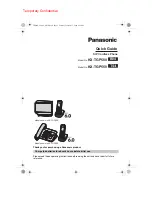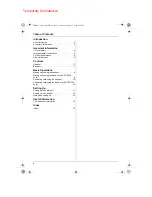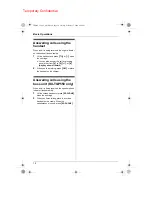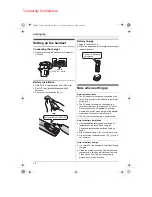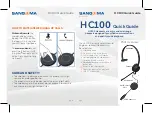
Temporary Confidential
Useful Information
13
FCC and other information
This equipment complies with Part 68 of the FCC rules
and the requirements adopted by the ACTA. On the
bottom of this equipment is a label that contains,
among other information, a product identifier in the
format US:ACJ----------.
If requested, this number must be provided to the
telephone company.
L
Registration No.............
(found on the back of the unit/KX-TGP500)
(found on the bottom of the unit/KX-TGP550)
L
Ringer Equivalence No. (REN).......0.1B
A plug and jack used to connect this equipment to the
premises wiring and telephone network must comply
with the applicable FCC Part 68 rules and requirements
adopted by the ACTA. A compliant telephone cord and
modular plug is provided with the product. It is
designed to be connected to a compatible modular jack
that is also compliant.
The REN is used to determine the number of devices
that may be connected to a telephone line. Excessive
RENs on a telephone line may result in the devices not
ringing in response to an incoming call. In most but not
all areas, the sum of RENs should not exceed five
(5.0). To be certain of the number of devices that may
be connected to a line, as determined by the total
RENs, contact the local telephone company. For
products approved after July 23, 2001, the REN for the
product is part of the product identifier that has the
format US:AAAEQ##TXXXX. The digits represented by
## are the REN without a decimal point (e.g., 03 is a
REN of 0.3).
If this equipment causes harm to the telephone
network, the telephone company will notify you in
advance that temporary discontinuance of service may
be required. But if advance notice isn't practical, the
telephone company will notify the customer as soon as
possible. Also, you will be advised of your right to file a
complaint with the FCC if you believe it is necessary.
The telephone company may make changes in its
facilities, equipment, operations or procedures that
could affect the operation of the equipment. If this
happens the telephone company will provide advance
notice in order for you to make necessary modifications
to maintain uninterrupted service.
If trouble is experienced with this equipment, for repair
or warranty information, please contact a Factory
Service Center or other Authorized Servicer. If the
equipment is causing harm to the telephone network,
the telephone company may request that you
disconnect the equipment until the problem is resolved.
Connection to party line service is subject to state
tariffs. Contact the state public utility commission,
public service commission or corporation commission
for information.
If your home has specially wired alarm equipment
connected to the telephone line, ensure the installation
of this equipment does not disable your alarm
equipment. If you have questions about what will
disable alarm equipment, consult your telephone
company or a qualified installer.
This equipment is hearing aid compatible as defined
by the FCC in 47 CFR Section 68.316.
When you hold the phone to your ear, noise might be
heard in your Hearing Aid. Some Hearing Aids are not
adequately shielded from external RF (radio
frequency) energy. If noise occurs, use an optional
headset accessory or the speakerphone option (if
applicable) when using this phone. Consult with your
audiologist or Hearing Aid manufacturer about the
availability of Hearing Aids which provide adequate
shielding to RF energy commonly emitted by digital
devices.
WHEN PROGRAMMING EMERGENCY NUMBERS
AND(OR) MAKING TEST CALLS TO EMERGENCY
NUMBERS:
1) Remain on the line and briefly explain to the
dispatcher the reason for the call.
2) Perform such activities in the off-peak hours, such
as early morning or late evenings.
This device complies with Part 15 of the FCC Rules.
Operation is subject to the following two conditions:
(1) This device may not cause harmful interference,
and (2) this device must accept any interference
received, including interference that may cause
undesired operation.
Privacy of communications may not be ensured when
using this phone.
CAUTION:
Any changes or modifications not expressly approved
by the party responsible for compliance could void the
user’s authority to operate this device.
NOTE:
This equipment has been tested and found to comply
with the limits for a Class B digital device, pursuant to
Part 15 of the FCC Rules. These limits are designed to
provide reasonable protection against harmful
interference in a residential installation. This
equipment generates, uses, and can radiate radio
TGP500_550_04_QG(E).book Page 13 Tuesday, February 17, 2009 4:59 PM
If the equipment is causing harm to the telephone
network, the telephone company may request that you
disconnect the equipment until the problem is resolved.
WHEN PROGRAMMING EMERGENCY NUMBERS
AND(OR) MAKING TEST CALLS TO EMERGENCY
NUMBERS:
1) Remain on the line and briefly explain to the
dispatcher the reason for the call.
2) Perform such activities in the off-peak hours, such
as early morning or late evenings.
This device complies with Part 15 of the FCC Rules.
Operation is subject to the following two conditions:
(1) This device may not cause harmful interference,
and (2) this device must accept any interference
received, including interference that may cause
undesired operation.
Privacy of communications may not be ensured when
using this phone.
CAUTION:
To assure continued compliance with FCC rules, do not
make any unauthorized changes or modifications to this
equipment would void the user's authority to operate this
device.
NOTE:
This equipment has been tested and found to comply
with the limits for a Class B digital device, pursuant to
Part 15 of the FCC Rules. These limits are designed to
provide reasonable protection against harmful
interference in a residential installation. This
equipment generates, uses, and can radiate radio
frequency energy and, if not installed and used in
accordance with the instructions, may cause harmful
interference to radio communications. However, there is
no guarantee that interference will not occur in a
particular installation. If this equipment does cause
harmful interference to radio or television reception,
which can be determined by turning the equipment off
and on, the user is encouraged to try to correct the
interference by one or more of the following measures:
– Reorient or relocate the receiving antenna.
– Increase the separation between the equipment and
receiver.
– Connect the equipment into an outlet on a circuit
different from that to which the receiver is connected.
– Consult the dealer or an experienced radio/TV
technician for help.
FCC RF Exposure Warning:
L
This product complies with FCC radiation exposure
limits set forth for an uncontrolled environment.
L
To comply with FCC RF exposure requirements, the
base unit must be installed and operated 20 cm (8
inches) or more between the product and all person’s
body (excluding extremities of hands, wrist and feet).
L
This product may not be collocated or operated in
conjunction with any other antenna or transmitter.
L
The handset may be carried and operated with only
the specific provided belt-clip. Other non-tested belt-
clips or similar body-worn accessories may not
comply and must be avoided.
Notice
L
FCC ID can be found inside the battery compartment
or on the back/bottom of the units.
FCC Declaration of Conformity
Trade Name: Panasonic
Model Number: KX-TGP500/KX-TGP550
Responsible Party: Panasonic Corporation of North America
One Panasonic Way
Secaucus, NJ 07094 U.S.A.
Telephone No.: 1-800-211-PANA (7262)
This telephone provides magnetic coupling for hearing aids.
For body-worn operation, the handset must be used
only with a non-metallic accessory. Use of other
accessories may not ensure compliance with FCC
RF exposure requirements.

